Carbon Monoxide Detector for Home: Details on Leak Detectors
Carbon monoxide poisoning, unfortunately, is not such a rare accident that accompanies illiterate operation of a solid fuel or gas boiler, fireplace, gas stove, column. The spread of toxic substances can also occur if defective equipment is used. A frightening prospect, agree.
A miniature device - a carbon monoxide detector for the home will promptly warn the owners, eliminate negative consequences. It reliably detects the appearance of harmful substances in the air. Here you will learn how to choose it correctly, where to install it, how to track and respond to instrument readings.
In the article we presented, the principle of action is thoroughly analyzed, the types of sensors that provide household safety are given. The installation process is carefully described, valuable recommendations are given. To optimize perception, the material is supplemented by visual illustrations and video tips.
The content of the article:
Carbon monoxide and its negative impact
Carbon monoxide, or as it is also called CO, is a product of the oxidation of substances at high temperatures, in other words, carbon monoxide is formed during combustion. CO is always released in small amounts during cooking.
However, exceeding the permissible gas content in the room is fraught with severe health damage, and sometimes can be fatal.
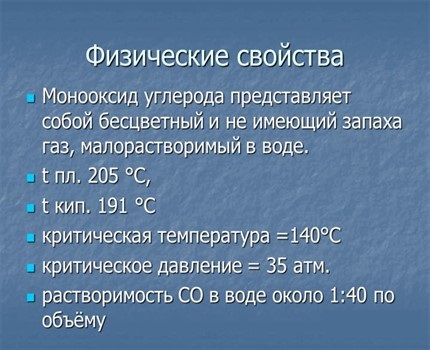
Only special devices are able to detect a substance in the air, because the gas has no smell or color. In addition, it has a toxic effect on the body at the time of inhalation.
Once in the lungs, carbon monoxide comes into contact with hemoglobin, resulting in a reaction - carboxyhemoglobin.The substance interferes with the saturation of blood cells with oxygen and causes hypoxia of body tissues.
To determine the presence of gas in the air, sensors are used, the scope of use of which is shown by a photo selection:
As a result, the functioning of the internal organs is disrupted, the nervous system and the brain are primarily affected.
The strength of poisoning depends on the amount of carbon monoxide in the room:
- With CO levels of 0.08%, the first symptoms of poisoning are mild malaise and drowsiness.
- Then begins a headache and dizziness, a cough appears.
- In especially severe cases, there is a lesion of the mucous membranes of the nasopharynx, blanching of the skin and impaired heart function.
- With an increase in the level to 0.32% due to oxygen starvation, loss of consciousness, coma and paralysis occur, with death occurring within half an hour.
- If the gas level rises to 1.2%, a person dies after 3 minutes.
Leakage occurs mainly in private buildings due to malfunctioning ventilation and chimney channels. In addition, gas appliances, boilers and other equipment often fail, and as a result, the level of CO rises in the room.
An example is the most common case when poisoning occurs during sleep, because it is impossible to identify fumes by smell.
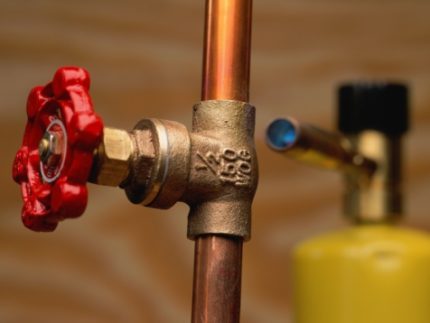
To save, the injured must be immediately taken to fresh air. It is also recommended to carry out deep ventilation of the lungs using an oxygen mask.
Often the cause of the leak is poor draft over an open flame source, an illiterate smoke exhaust system, or a gas stove malfunction. Living in the private sector, you must follow safety precautions when using heating elements.
When firing solid fuel boilers and furnaces, the shutter must not be closed ahead of time. In addition, the layout of some private houses also includes an attached garage, which can lead to excessive emission of waste and getting it into the residential part of the room. This is especially dangerous if the extension is poorly ventilated.
Emergency Protection
To eliminate false concerns about a possible leak, it is worthwhile to install a carbon monoxide identification system. The device will inform you about the air condition in the room and notify residents if toxic fumes are exceeded.
The detector does a good job of recognizing not only CO, but will also inform residents about the leakage of domestic gas. If a fire has already begun, the sensor will not recognize it, but in terms of preventive measures, it is indispensable.
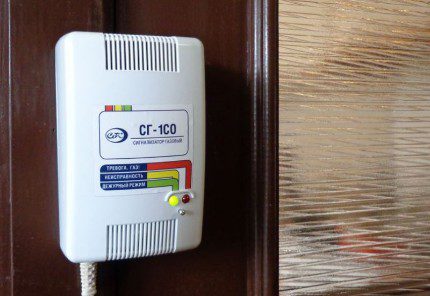
The device will instantly respond to changes in the chemical composition of air. According to the installation rules, it is best not to install sensors in the immediate vicinity of open flame sources, but simply in the same room with heating equipment.
If the room is equipped with several heating units, it is necessary to organize a system of an equal number of detectors.
A wide range of manufacturers each year provides consumers with various carbon monoxide detection devices. Despite the fact that the form factor of each device is determined individually, the construction principle is almost always the same.
A photo introduces the principle of operation and the specificity of the sensor device:
A distinctive feature of the gas detection device is that the detector is not designed for smoke identification. So, in addition to the CO sensor, it is recommended to separately install the fire safety system.
The reaction of the sensor to exceeding the permissible parameters in the air is an audible signal that indicates the leakage of toxic gas. Before operation, it is necessary to read the instructions and test the device in an accessible, non-hazardous way, as Often people confuse the CO leak signal with a low battery indicator.
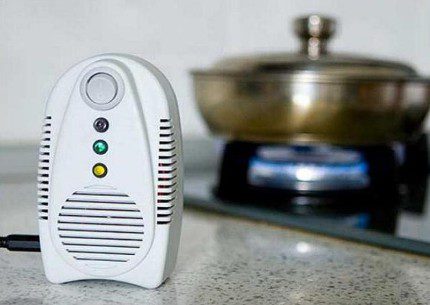
Also, almost all devices have a function own fault notifications. The tone and interval of each sound is different. If the detector indicates a discharged battery, the sound in most cases has a clear jerky character and occurs 1 time per minute.
It is recommended to timely replace the battery, since the health and life of households depends on the proper functioning of the device. Mostly, replacement should be done no more than 2 times a year.
A constant squeak of a detector may indicate an increase in the level of toxins in the air, or a breakdown in equipment. In any case, an emergency service must be called immediately.
If poisoning symptoms are detected, you must immediately open all the windows and leave the room, wait for the brigade on the street.
Specialists will check oxygen levels and identify leaks. If it still turns out that the signal is false, the detector will need to be replaced with a new one.
Some sensors for carbon monoxide and natural gas for the home are able to recognize even fairly safe substances with a high degree of evaporation. This primarily applies to alcohol and all alcohol-containing liquids.
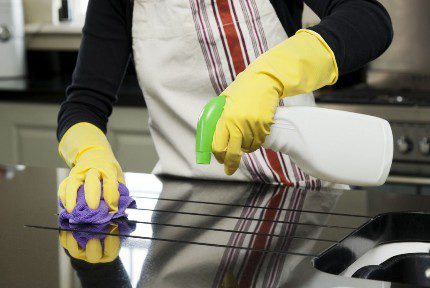
With a high concentration of vapor, the system can give an alarm, but do not worry and immediately call the emergency service.Also, the operation of the detector can occur during cooking of some products, mainly subjected to the process of pickling.
This is mainly characteristic when the appliance is close to the hob. If this happens quite often, you should install the sensor away from the center of culinary procedures.
Types of air analyzers and their advantages
Increasingly, people are resorting to certain types of household CO sensors. The most popular options include 3 main types of devices:
- Semiconductor detectors.
- Infrared sensors
- Devices with an electrochemical determination method.
In order to understand which of the devices will perfectly cope with the task of detecting dangerous gas, it will be suitable by the means and methods of installation, you need to understand their specifics.
# 1: Semiconductor Gas Detectors
The equipment of the first type is fundamentally different from the other two, because It works on the principle of chemical processes of interaction of atoms of substances. In most cases, dioxides are used as the active substance, namely carbon, tin and ruthenium.
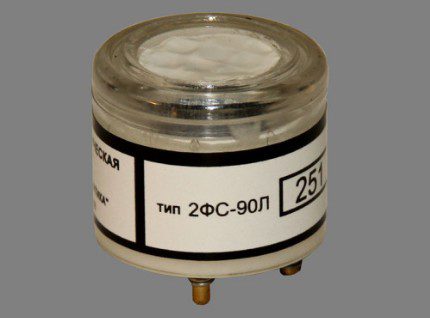
A method for determining toxins is to increase the conductivity of the affected air. As a result of this, the components of the detector come into contact. Then a mechanism is activated that signals the presence of carbon monoxide. The reaction takes place between atoms.
Sno2 (tin dioxide) or RuO2 (ruthenium dioxide). For the diffusion of atoms, it is necessary that the chemical elements are exposed to heat at a temperature of at least 250 degrees Celsius.
Clean air conductivity in a SnO device2 and RuO2 extremely small, so the device is active only under the condition of the presence of CO.
When heated from oxygen atoms under the influence of carbon monoxide, electrons begin to liberate. This process increases the conductivity of the detector capsule, due to which the sensor contacts are closed, and as a result, an alarm is triggered.
The voltage primarily depends on the amount of CO monoxide in the air. When the permissible level is exceeded, the voltage rises, so there are practically no false positives detected behind the semiconductor detector.
The only exceptions are cases when the device is located too close to the hearth of the fireplace, the stove firebox, geyser burner. This is true for all types of equipment. Therefore, installation is recommended at a certain distance from the heating panels.
The design of a semiconductor sensor begins with a solid base. It is made of a polymeric material related to saturated polyesters. The case itself is made of stainless steel. The frontal part plays the role of an inlet where air affected by toxins enters.
In order to avoid the penetration of concomitant combustion substances, the detector housing contains a carbon layer. The latter serves as an absorbent. A double layer of stainless steel mesh is also provided to protect against physical contaminants such as dust.

In most cases, semiconductor sensors have 3 pins for connecting electricity. This is due to the fact that the design of the device contains 2 electrical circuits - for the heater, and for the element of metal dioxide.
This type of sensor is characterized by a high degree of wear resistance and a long service life. In addition, due to its small size, it consumes extremely little electricity, but by the level of CO determination, the device is on the list of the most efficient.
The video represents a semiconductor detector device, an example of a sensor’s operability:
# 2: Infrared analyzer
A completely different principle of operation is observed for infrared sensors. Here, air is used as an analyzer, which is then checked for the presence of CO by means of infrared radiation.
The main criterion that determines the level of carbon monoxide is the wave spectrum of the IR element, which absorbs carbon monoxide toxin molecules. Due to the fact that light is much more sensitive to external influences, sensors of this type successfully identify many pollutants, including methane.
The IR sensor is programmed to a specific CO level, which is considered a reference indicator. If the set limit is exceeded, an alarm is triggered.
The role of the sensitive element is performed by an LED or an incandescent filament. Such IR gas leakage sensors are called non-dispersive. The gas level is analyzed thanks to special filters that are configured to perceive only a specific spectrum.
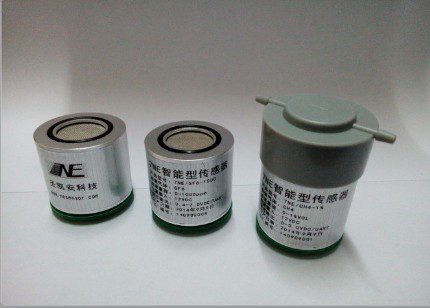
In the event of a change in the chemical composition of the air, the element reacts, the light wave changes, and the detector detects the excess of the permissible level of the desired gas. The level of spectrum change is directly proportional to the percentage of chemical in the air.
Detectors of this type are often used not only in everyday life, but also as special devices for detecting toxic leaks. The selectivity of the equipment allows it to successfully scan the air for the presence of heavy gases such as ammonia and chlorine.
As for the design, the device is powered by means of connecting to a 220 V network. However, in most options for household devices provides the ability to work on batteries.
To indicate gas contamination, the device is equipped with a backlit display and an audible alarm system. If a gas leak is detected, the sensor will immediately give a clear jerky squeak, and the device’s monitor will blink.
# 3: Catalytic gas detectors
The main difference between electrochemical sensors is a rather small level of energy consumption. This is due primarily to the fact that in the design of the device there is no heating element, and the role of a sensitive substance is played by liquid electrolyte.
Therefore, the equipment may well do without connecting to the network, and work on rechargeable batteries. The structure of the sensor is such that an analysis of the air condition is carried out by determining the level of oxidation of the substance inside the capsule of the device. As a rule, the medium of electrochemical reactions is a galvanic cell filled with a liquid alkaline solution (mainly potassium).
As practice shows, alkalis have some disadvantages, among which there is a low resistance to carbon monoxide and a low shelf life.
Nevertheless, some manufacturers prefer to create an electrolytic environment using a mixture of acid solutions. Such a cell is much more resistant to external molecules and, as a result, is more durable.
The gas molecules (in this case, CO) are in contact with the electrode of the device, as a result of which a chemical oxidation reaction occurs. The electrolyte fixes the level of voltage that has arisen and translates this indicator into the gas content level. The higher the percentage of fumes, the stronger the electrolysis.
The alarm control process is carried out by a small microcircuit, in which the specific level of fumes is registered. Therefore, according to a familiar principle, if the norm is exceeded, the sensor signals a danger.
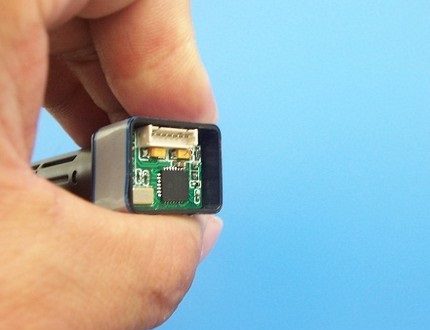
To maintain the purity of the active medium along with semiconductor sensors, a carbon filter is often placed in the housing, which traps unwanted molecules mixed with carbon monoxide. Thus, the effectiveness of the device is supported by a chemical system. protection, which reduces the likelihood of false activation.
Some models allow the replacement of spoiled electrolyte and refill the galvanic capsule.
The advantages of catalytic sensors and the principle of their operation are demonstrated in the video:
Features of gas sensors
The form factor of some devices assumes the presence of a so-called electromagnetic relay, through which it is possible to connect the sensor to the gas pipeline valve plug system.
The purpose of the system is mainly that such a sensor, when an alarm is triggered, instantly shuts off the gas supply in the pipe, thereby ensuring complete safety.
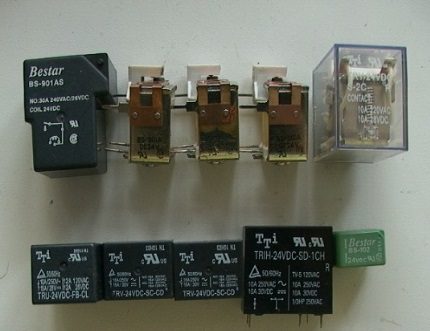
Modern equipment also provides a number of functions for warning of an emergency using a conventional mobile phone. In most cases, systems of this kind are characteristic of imported devices and it is rather difficult to meet them among domestic analogues.
Nevertheless, some manufacturers have taken care of the possibility of connecting additional GSM peripherals to notify the owner of the house via SMS.
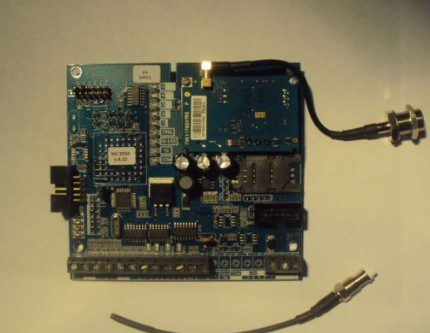
Alarm Installation Process
Most detectors come with a special mounting element, on which the device will be subsequently planted. It is recommended that you mount on a wall closer to the ceiling.
It should be noted that in European countries the mounting of a carbon monoxide detector on a wall next to gas boiler or a fireplace is a gross violation. Installation there is allowed to be carried out only on the ceiling, in contrast to the CIS, where the installation of the sensor often occurs at a distance of at least 1.5 m from the floor.
Since the sensors record not only carbon monoxide, but also natural gas, you need to understand some of the features of the installation. When arranging a gas alarm system, the device should be mounted at different heights.
If the house is connected to a pipeline with natural gas, the sensor must be placed closer to the ceiling. In the case of bottled gas - closer to the floor. This is explained by the different density of gaseous combustible substances.
Natural lighter than the liquefied balloon option. With a leak, it rises, while the balloon, on the contrary, first fills the lower levels of the room.
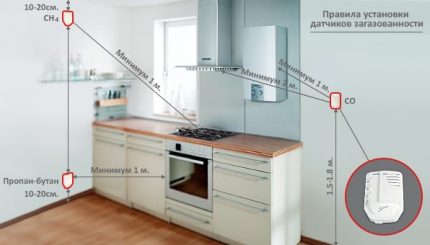
When organizing a gas leak prevention system, you should not rely 100% on the functions of the sensor. The device performs only the monitoring task and will not be able to protect the lives of people in the event of an emergency.
Before installation, check as necessary ventilation system. If it is working, install it.

The process of connecting the sensor to the power supply network must be carried out by an exclusively competent specialist, otherwise problems may arise if the power supply is not properly organized. Do not neglect this rule, and it is better to contact a professional, becausesomeone’s life depends on the success of the enterprise.
When choosing the location of the module, make sure that at least one of the sensors is located in the bedroom. This is important to consider. Indeed, most of the accidents associated with the leak of carbon monoxide occur during sleep.
If the house consists of several floors, it is necessary to provide an anti-fire system with each floor of the room through which the components pass autonomous heating system.
When mounting the sensor in the same room as the fire source, the minimum distance between the source and the sensor should be observed. As a rule, for an objective analysis of air, you need to observe a distance of 4-5 m.
Some sensor models trigger when the air temperature rises above 50 degrees. Such a phenomenon takes place when a fire started in the room and the flame source is in close proximity to the device. At the same time, the amount of waste generated may still not reach the alarming mark.
The appliance must be located in such a place that nothing interferes with the flow of air. This is typical for cases where the detector mount is behind the curtain. Air circulation around the sensor is the main point that you need to pay attention to. Because some interior objects can block the inlet of the device and as a result, the system will not provide 100% protection.
There are several ways to check the performance of the analyzer. The easiest is to buy a special spray can with CO. By spraying it near the detector, you can verify that the installation operation is correct.
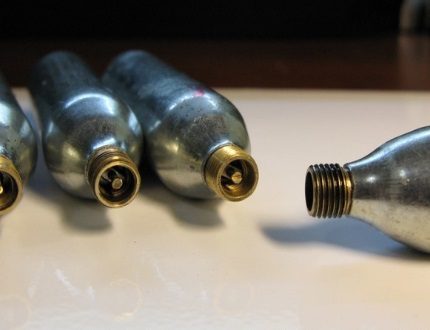
It is worth observing some points when implementing this process. Firstly, in no case do you need to direct the aerosol stream directly onto the device. This is important, because the direct concentration of the substance is ten times higher than the actual amount needed to trigger the sensor.
Such an enterprise can either adversely affect the functionality of the sensor, or simply disable it. Most manufacturers insist on specialized equipment testing by qualified technicians. Naturally, the procedure is paid, but in this way you can be sure that the CO detector is working properly.
In order to avoid breakdowns, you need to monitor the cleanliness of the room, trouble-free ventilationFirst of all, try to prevent dust accumulation on the sensor housing.
Conclusions and useful video on the topic
The main safety violations during the installation of gas equipment and recommendations on how to avoid carbon monoxide poisoning:
Carbon monoxide is dangerous because at high concentrations it can kill in a matter of minutes. Detectors will take care of home safety by organizing round-the-clock monitoring of air composition. The choice of device depends only on personal preferences and the price of the device.
Please write comments: share your experience in choosing and using gas analyzers, ask questions. We and site visitors are ready to participate in the conversation and highlight obscure points.

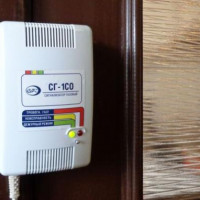 Gas leakage sensor with shutoff valve: device, classification + how to choose and install correctly
Gas leakage sensor with shutoff valve: device, classification + how to choose and install correctly 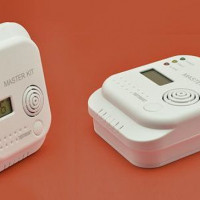 Battery gas leak sensors: operating principle and varieties + best brands on the market
Battery gas leak sensors: operating principle and varieties + best brands on the market 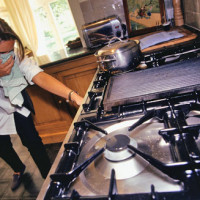 What to do if a gas stove passes gas: causes of gas leakage and their elimination
What to do if a gas stove passes gas: causes of gas leakage and their elimination 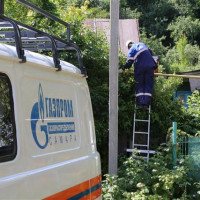 Where to call if there is no gas in the apartment: reasons for disconnection + procedure for the absence of gas
Where to call if there is no gas in the apartment: reasons for disconnection + procedure for the absence of gas 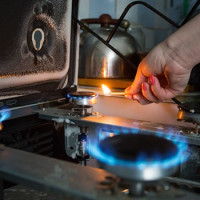 Types of domestic gas: what gas comes to our apartments + features of domestic gas
Types of domestic gas: what gas comes to our apartments + features of domestic gas  Actions for the smell of gas in the boiler room: what to do when a characteristic odor is detected
Actions for the smell of gas in the boiler room: what to do when a characteristic odor is detected  How much does it cost to connect gas to a private house: the price of organizing gas supply
How much does it cost to connect gas to a private house: the price of organizing gas supply  The best washing machines with dryer: model rating and customer tips
The best washing machines with dryer: model rating and customer tips  What is the color temperature of light and the nuances of choosing the temperature of the lamps to suit your needs
What is the color temperature of light and the nuances of choosing the temperature of the lamps to suit your needs  Replacement of a geyser in an apartment: replacement paperwork + basic norms and requirements
Replacement of a geyser in an apartment: replacement paperwork + basic norms and requirements
In fact, an extremely useful contraption.And if many do not underestimate its importance and necessity, this is a real omission. And even if it may never come in handy, but if something unexpected and threatening happens suddenly, it can really save lives. Therefore, there should not even be questions regarding the need to install it. I strongly recommend using it as a useful protective device.
I set myself such a carbon monoxide detector in my country house. I think that in general in every house there should be such devices, because I had situations when he really helped to prevent a fire in the room on time. His sensitivity is good, it reacts instantly. The pluses of the sensor are that almost any person with at least a general idea of an electrician can install. I installed it myself according to the instructions. Satisfied with the carbon monoxide sensor.
“There are many ways to check the performance of the analyzer. The easiest is to buy a special spray can with CO ”. Further: “A can of carbon dioxide can be found in any hardware store.” I don’t know where to buy a can of carbon monoxide (CO), but checking the sensor with a carbon can (CO2) is somehow stupid and irresponsible.
I wrote a couple of such gizmos from China. For a country house very sensitive. If you follow their control, then no firewood will be enough. In a furnace, carbon monoxide manifests itself as blue lights jumping on coals. And the pipe closes as soon as they disappear and the heat begins to twitch lightly. But it is clear that nevertheless a certain amount is allocated, although not harmful to health. Now you have to somehow reconfigure the device ....
So I still do not understand which sensor is still more reliable? Semiconductor, catalytic or infrared? Where is this fine line between price / quality? All the same, the device is responsible and I would not want to buy a cat in a poke.
Maybe in the comments there are people who have such a sensor, tell me who knows.
Hello. Despite the higher cost, I recommend an infrared sensor. Such sensors quickly respond to gas contamination, have high accuracy, reliability and calibrate them, as a rule, no more than 1 time per year, which reduces the cost of maintenance. Unlike the other 2 species that need to be checked and calibrated at least once a quarter, they are not overly reliable and often fail due to various factors and gas contamination.
From personal experience, I can recommend the Mijia Honeywell Gas Alarm. The issue price is $ 50 and no special knowledge is needed to install the sensor. A big plus is that it connects via Wi-Fi interface to the proprietary application on your smartphone and you will always be aware of the current situation in the house, even if you are not there. In which case, the sensor delivers sound signals directly to its speakers, as well as to the smartphone, so a dangerous moment will not be taken by surprise even at night.
It reacts not only to carbon monoxide, but also natural, as well as other types of pollution that can cause harm to health, which is its main advantage. For such a price, I think the best option. The sensor is installed both individually and in the “smart home” system. You can buy it on Aliexpress or in Russian intermediary stores.
By the way, I recommend reading our new article about smart home from xiaomi, there just about this sensor is well told.
Hello! And which sensor do you recommend for carbon monoxide alerts? Thank.
Hello. We have already noted an excellent option for a budget and reliable type Mijia Honeywell Gas Alarm.
About Europe - “Installation is allowed to be carried out only on the ceiling, unlike the CIS,” - in Tallinn, the ordered company checked the ventilation (draft, columns, gas stoves), and simultaneously offered its Honeywell carbon monoxide sensors. And she gave recommendations on places - where to put, if people buy and put on their own.
So not on the ceiling, but on the side wall, under 90 degrees. from the column, and about the middle of the height of the wall. But not on the floor or on the ceiling! They bought the sensor themselves from another manufacturer (wallander, electro-chemical). Inside there is an instruction with a diagram where they also write what to put approximately in the middle of the height of the wall.
Good afternoon! Tell me, there is such a sensor that detects household gas, carbon monoxide and fumes, if a person has forgotten on a stove turned on a dish that starts to burn. With a notification sound and to the phone. Thank.
Hello. You ask about GSM sensors. Of course, they won’t determine that your food is burnt, but they will easily notice a gas leak and send you a message on the phone. We also recommend that you familiarize yourself with article.